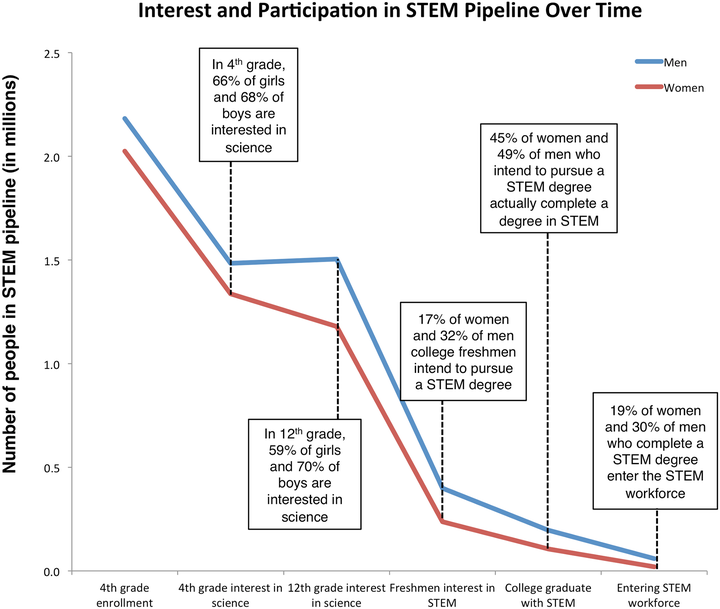
The gender gap in STEM (science, technology, engineering and mathematics) is widely reported. Only one-quarter of college graduates entering careers in STEM in the U.S. are women. The numbers are even more dismal in fields like physics and engineering. Only about 1 in 10 physicists and astronomers are women. About 8 percent of mechanical engineers are female.
But here’s the rub: Girls are just as interested and are definitely not less skilled in STEM subjects than boys. In fourth grade, both genders report similar rates of interest in science. From K-12, female and male students generally perform equally well on standardized math and science tests. High school boys and girls also enroll in advanced science courses at comparable rates.

So, what exactly happens to all these STEM-loving girls?
There are many “leaks” in the so-called STEM pipeline, including educational shortfalls and cultural issues like stereotyping. But there may be one issue in particular that’s having a profound impact on the number of women in STEM: the notoriously difficult college math class, Calculus I, a new study from Colorado State University finds.
Male and female students lose confidence in their math skills at a similar rate in Calc I. But women are far more likely to be discouraged by the class, a necessary process for those pursuing a career in STEM, according to the report, published in the journal PLOS ONE last month.
Researchers found that female students have the same level of academic preparedness and similar career goals as their male counterparts, yet they’re 1.5 times more likely than men to leave their STEM studies after taking Calc I.
Part of the problem is that women enter the class with less confidence in the first place. When comparing men and women with above-average mathematical abilities, the researchers found that female students had significantly lower mathematical confidence both at the start and the end of the college term.
The findings suggest that a major factor in women’s decisions to leave STEM paths after Calculus I have nothing to do with ability, but confidence in their ability. (Though this particular study did not examine students’ grades in the class, a 2015 paper about college math concluded that women outperform men in Calc I.)
“When women are leaving, it is because they don’t think they can do it – not because they can’t do it,” said study co-author Bailey Fosdick in a press release.
Fixing this leak at the “Calculus I juncture” of the STEM pipeline could have an extraordinary effect on the number of women continuing their studies and getting jobs in the field, the researchers said.
“Our findings indicate that if women persisted in STEM at the same rate as men starting in Calculus I, the number of women entering the STEM workforce would increase by 75 percent,” the study reads.
This boost could go a long way, researchers said, in fulfilling the need for more STEM workers in the U.S. The Obama administration has said that 1 million additional STEM graduates will be needed to fulfill demand by 2022.
To plug the leak, the researchers said a multi-pronged approach will be necessary to raise the confidence in all STEM students. Improving teaching quality and encouraging students will be critical first steps.
“If female students are entering college excited to be challenged, supported, and surrounded by like-minded STEM people and they have a negative initial experience with a STEM course, it makes sense that this could be the final experience to encourage them to pursue a different (and non-STEM) field,” Jessica Ellis, a study co-author and professor of mathematics at Colorado State University, told Vocativ on Tuesday.
Ellis said she tries to “raise the confidence” of all students in her classes. Since the study, she said she’s made a special effort “to make sure women have a voice ― and if they get something wrong once, to let them know that’s good and not bad.”
The study’s findings were based on the National Study of College Calculus from the Mathematical Association of America through a grant from the National Science Foundation. Read the entire study here.

